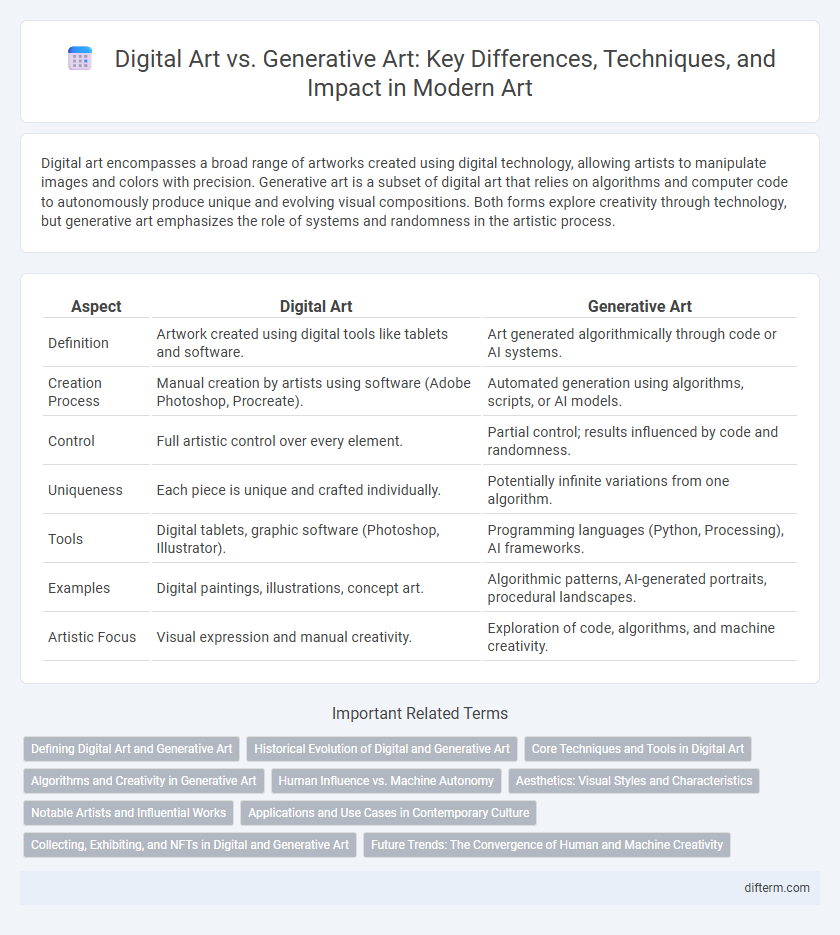Digital art encompasses a broad range of artworks created using digital technology, allowing artists to manipulate images and colors with precision. Generative art is a subset of digital art that relies on algorithms and computer code to autonomously produce unique and evolving visual compositions. Both forms explore creativity through technology, but generative art emphasizes the role of systems and randomness in the artistic process.
Table of Comparison
| Aspect | Digital Art | Generative Art |
|---|---|---|
| Definition | Artwork created using digital tools like tablets and software. | Art generated algorithmically through code or AI systems. |
| Creation Process | Manual creation by artists using software (Adobe Photoshop, Procreate). | Automated generation using algorithms, scripts, or AI models. |
| Control | Full artistic control over every element. | Partial control; results influenced by code and randomness. |
| Uniqueness | Each piece is unique and crafted individually. | Potentially infinite variations from one algorithm. |
| Tools | Digital tablets, graphic software (Photoshop, Illustrator). | Programming languages (Python, Processing), AI frameworks. |
| Examples | Digital paintings, illustrations, concept art. | Algorithmic patterns, AI-generated portraits, procedural landscapes. |
| Artistic Focus | Visual expression and manual creativity. | Exploration of code, algorithms, and machine creativity. |
Defining Digital Art and Generative Art
Digital art encompasses artwork created or manipulated through digital technology, including painting, photography, and animation produced via software tools. Generative art is a subset of digital art where algorithms, code, or autonomous systems independently generate the artwork, often introducing unpredictability and variation in the final piece. Understanding the distinction lies in digital art's manual digital creation versus generative art's automated, algorithm-driven process.
Historical Evolution of Digital and Generative Art
Digital art originated in the 1960s with early experiments in computer graphics and evolved through advancements in software and hardware, enabling artists to create complex visual compositions. Generative art emerged as a subset of digital art in the 1990s, characterized by algorithm-driven processes that autonomously produce unique and evolving artworks. The historical evolution of both forms reflects a shift from manual digital manipulation to autonomous systems leveraging artificial intelligence and machine learning models.
Core Techniques and Tools in Digital Art
Digital art primarily utilizes software platforms like Adobe Photoshop and Procreate, emphasizing techniques such as digital painting, photo manipulation, and vector illustration. Generative art relies on algorithmic processes and coding languages such as Processing, p5.js, and Python libraries to create dynamic, evolving artworks through artificial intelligence and procedural generation. Both disciplines demand mastery of digital tools, but generative art integrates computational logic, producing artworks that adapt and transform based on predefined rules or random inputs.
Algorithms and Creativity in Generative Art
Generative art leverages complex algorithms and computational processes to produce unique, often unpredictable visual outcomes, showcasing a dynamic intersection between technology and creativity. Unlike traditional digital art, which is manually crafted with specific intentions, generative art embraces randomness and self-evolving code that enables continuous innovation and variation. This algorithm-driven creativity pushes artistic boundaries, allowing creators to explore new aesthetic possibilities beyond human limitations.
Human Influence vs. Machine Autonomy
Digital art often reflects a direct human influence where artists manually create or manipulate images using software, emphasizing intentionality and personal expression. Generative art involves algorithms and machine autonomy to produce visuals, with the artist setting parameters but the machine generating unpredictable outcomes. This distinction highlights how control shifts from human creativity in digital art to collaborative unpredictability between artist and machine in generative art.
Aesthetics: Visual Styles and Characteristics
Digital art encompasses a broad range of visual styles defined by human creativity, often featuring highly detailed, controlled compositions with vibrant color palettes and precise brushwork. Generative art leverages algorithms and computational processes to produce evolving, autonomous visuals characterized by randomness, repetition, and organic patterns. The blend of computational logic and artistic expression in generative art creates unique aesthetics that contrast with the deliberate craftsmanship found in traditional digital artworks.
Notable Artists and Influential Works
Notable digital artists like Cory Arcangel and Jenny Holzer have pioneered the use of technology and digital media to create provocative, immersive artworks that challenge traditional aesthetics. Influential generative artists such as Joshua Davis and Casey Reas utilize algorithms and code to produce evolving, interactive visuals that blur the boundaries between art and computation. Key works like Davis's "Praystation" and Reas's "Software Structures" exemplify the dynamic innovation within digital and generative art spheres, shaping contemporary artistic practices.
Applications and Use Cases in Contemporary Culture
Digital art encompasses a wide range of applications, including graphic design, digital painting, and multimedia installations, popular in advertising, entertainment, and fine art. Generative art utilizes algorithms and artificial intelligence to create evolving, dynamic visuals frequently employed in interactive media, virtual environments, and experimental art projects. Contemporary culture increasingly embraces generative art for its ability to produce unique, data-driven aesthetics, while digital art remains foundational in commercial and creative industries.
Collecting, Exhibiting, and NFTs in Digital and Generative Art
Collecting digital art often involves acquiring unique or limited-edition NFTs, which authenticate ownership and provenance on blockchain platforms. Exhibiting generative art emphasizes its algorithmic creation process through dynamic installations or interactive displays, enhancing viewer engagement. NFTs in generative art serve as digital certificates for constantly evolving pieces, enabling collectors to invest in continuously transforming artworks within decentralized marketplaces.
Future Trends: The Convergence of Human and Machine Creativity
Digital art and generative art are rapidly evolving through the integration of artificial intelligence and machine learning, enabling unprecedented collaboration between human intuition and algorithmic processes. Future trends indicate a seamless convergence where artists harness AI tools to amplify creativity, producing dynamic, adaptive works that respond to environmental inputs or viewer interaction. This fusion challenges traditional artistic boundaries, fostering new forms of expression that blend human emotion with computational innovation.
digital art vs generative art Infographic

 difterm.com
difterm.com